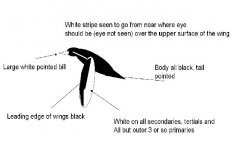Imaginos said:
Forgive me for not knowing the precise distribution of large raptors in North America, not my strong point admittedly. Thus clarifying my position in the above post to bring a bald eagle/golden eagle analogy more into line with the IBWO/PIWO/crow/duck/whatever else
I'm not sure that these casts can really tell us much in isolation can they? IBWO is/was a larger bird, thus would have a larger bill, the proportions do not look that much different, which with a poor view when you really want to see one bird over another could be confused?
But surely with all these sightings someone must have noticed a large white bill, are the woods so dark that the lighting will always make a white bill look dark?
Are the 'believers' really more open minded about what they are seeing? Most are sightings by people who are actively out looking for IBWO, most will have invested a lot of time and money personally into proving the existence of a bird long thought extinct. Surely that will have an effect on what they choose to see/ignore in any potential sightings.
)
Careful: an admission here that you don't know everything is considered a very fatal flaw by some of the more "open" minded people here.
To answer your question the proportions are very much different and the bill colour is also very much different from a pileated. An ibwo is compared to a bill more like an egret to me than a woodpecker. The point is very sharp, and is very narrow side to side but top to bottom it flares very quickly. It is a much different shaped bill than a pileated. This from side by side comparisons of mounts.
The ibwo bill to pileated bill is much larger to my eye in proportions than the birds themselves are to each. Again, the shape is also much different. I had posted measurements I believe some time ago.
As for lighting the woods can be very dark such that in daylight the photo of an orchard oriole (not very hard to distinguish) threw three of us for some time because the colourings of the bird were not distinguishable. It really depends on where you are and where the bird is in relation to the sunlight. It was just a dark photo because of lighting.
It also depends on the tree species present. If just bald cypress swamp (or predominantly bald cypress) an area may get a greenish hue to it while the canopy of the hardwoods may completely block sunshine. It is easy to see once therein why a person may not see the bird because of lack of light, lack of visual lines, canopy, and lack of accessibility.
A white bill may not always look dark, but there are other issues. If the bird has its back to you the bill may not be visible. Distance to the bird on an oblique view, etc.
Plus it is pretty hard just to find the sucker in the first place. While some laughingly say "well, its easy to find the bird why not photo it?" they readily prove out their ignorance every time they say something to that effect. This bird is hard to find, quick, moves quickly, and doesn't stay still for photos.
As for choosing to ignore facts I don't ignore anything. I try to accurately note everything, and leave it for what it is. Inaccuracy is not helpful and in fact is harmful to the effort. If this means changing hypothesis as facts disprove them so be it. That is how this will move forward. Or some clown with a instamatic camera will just be lucky and get a picture.





